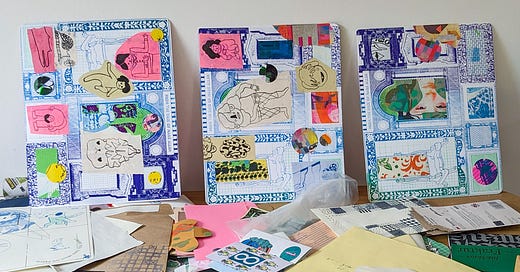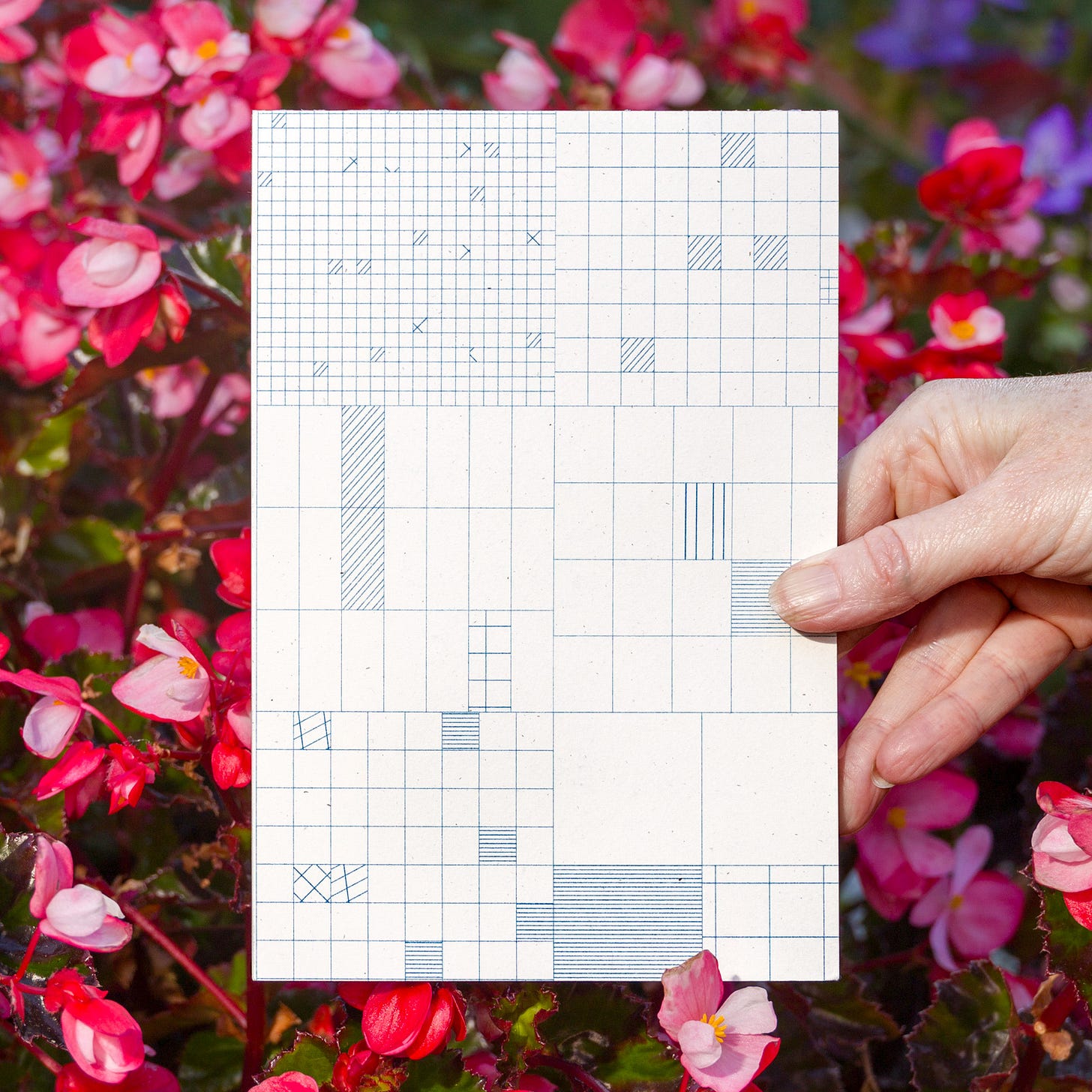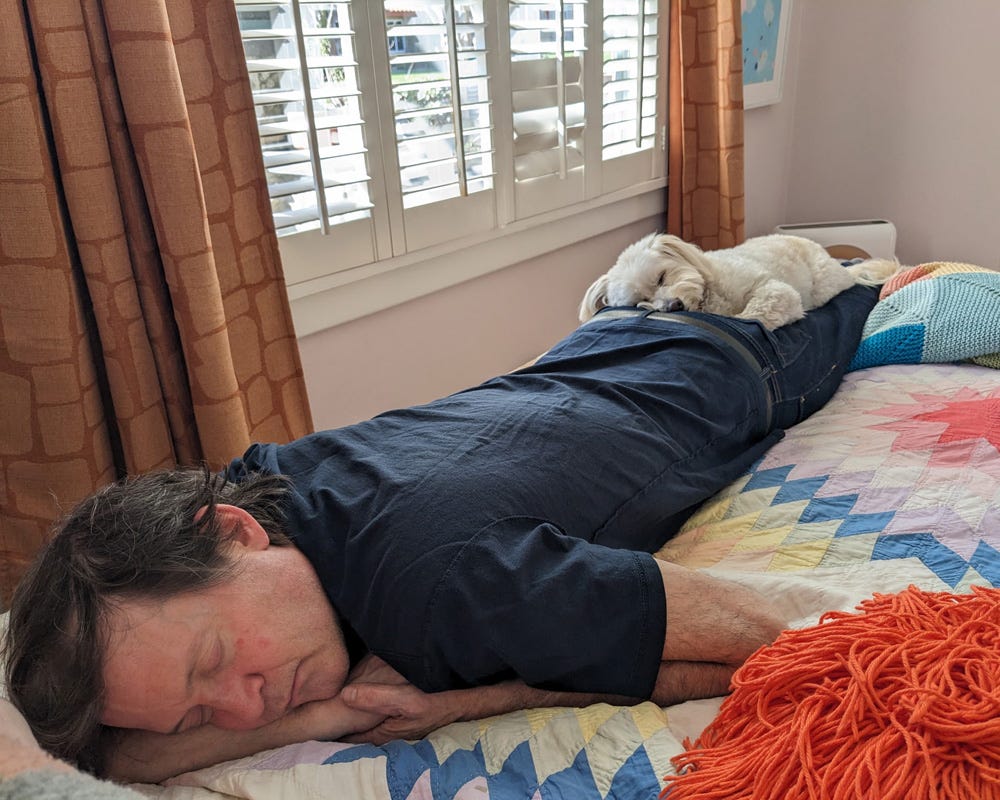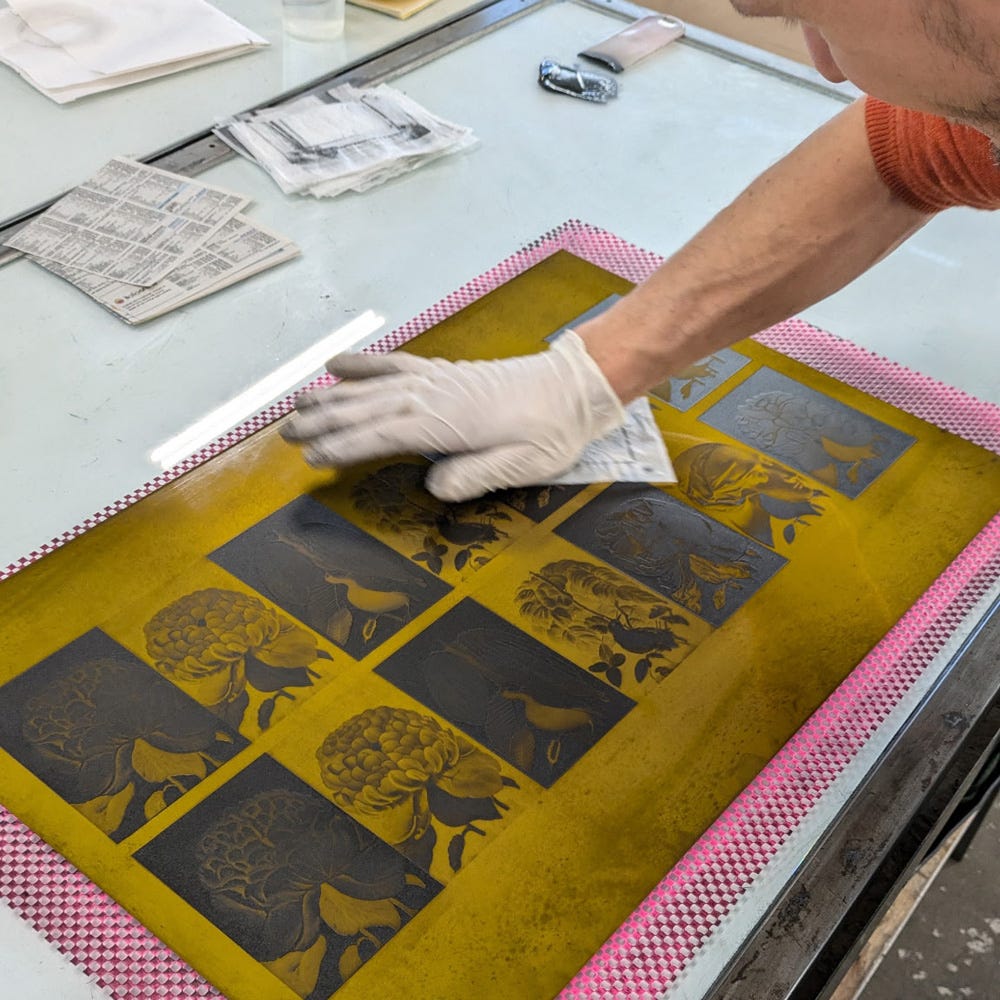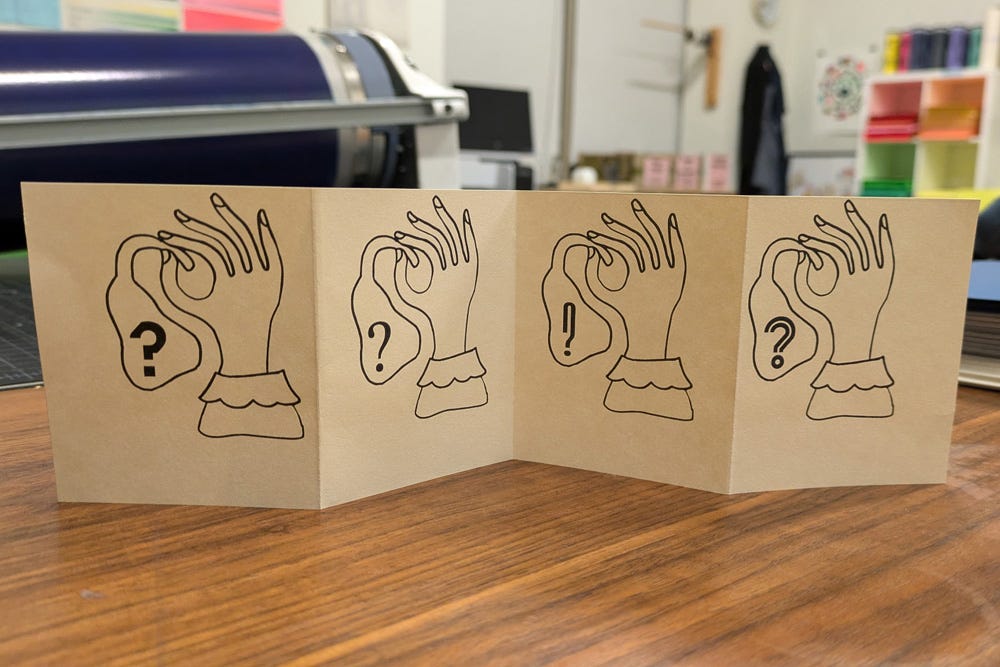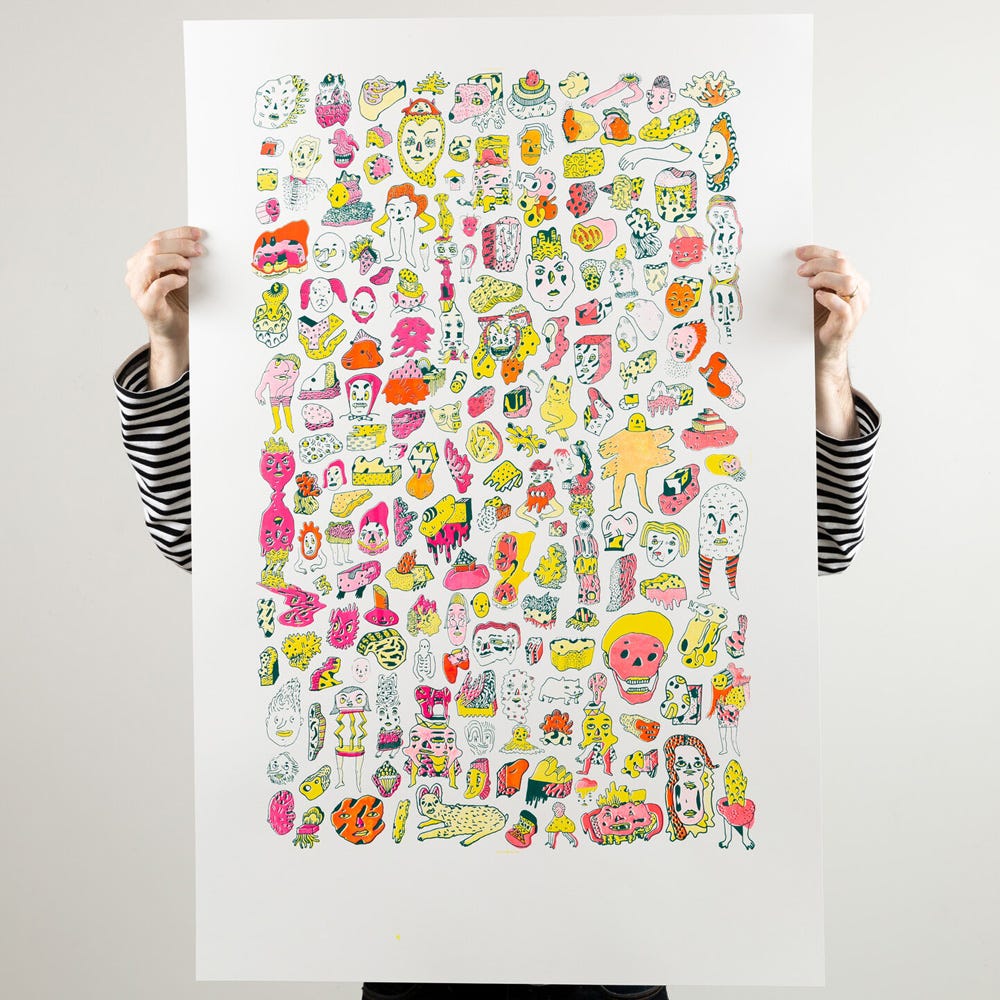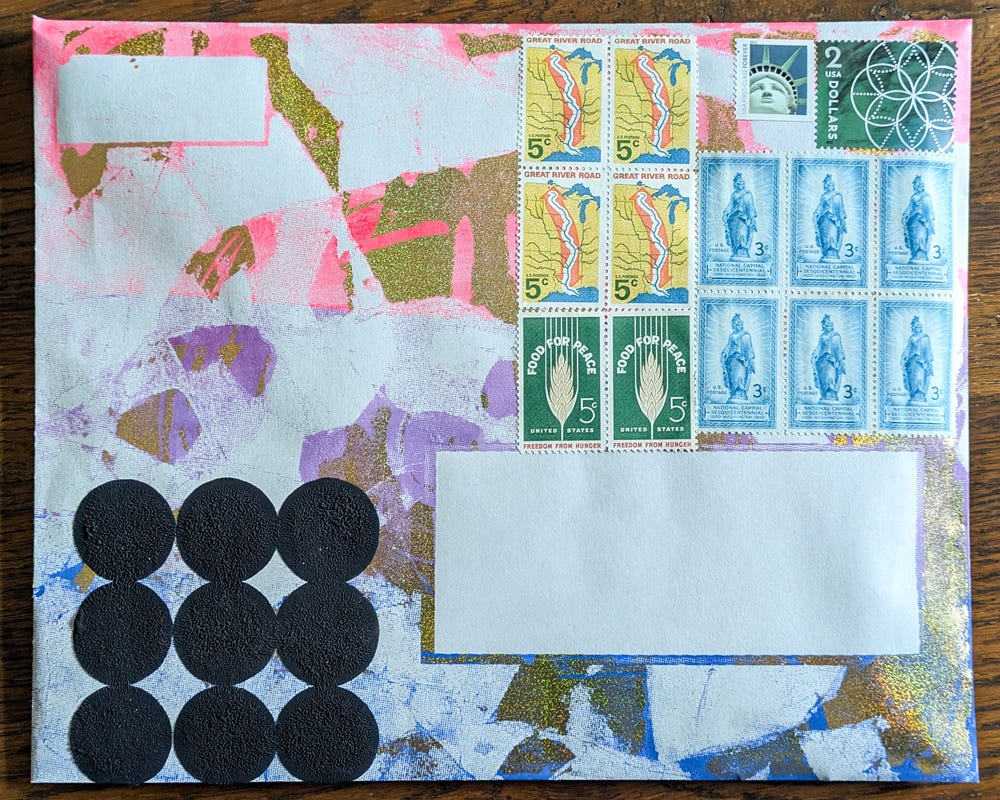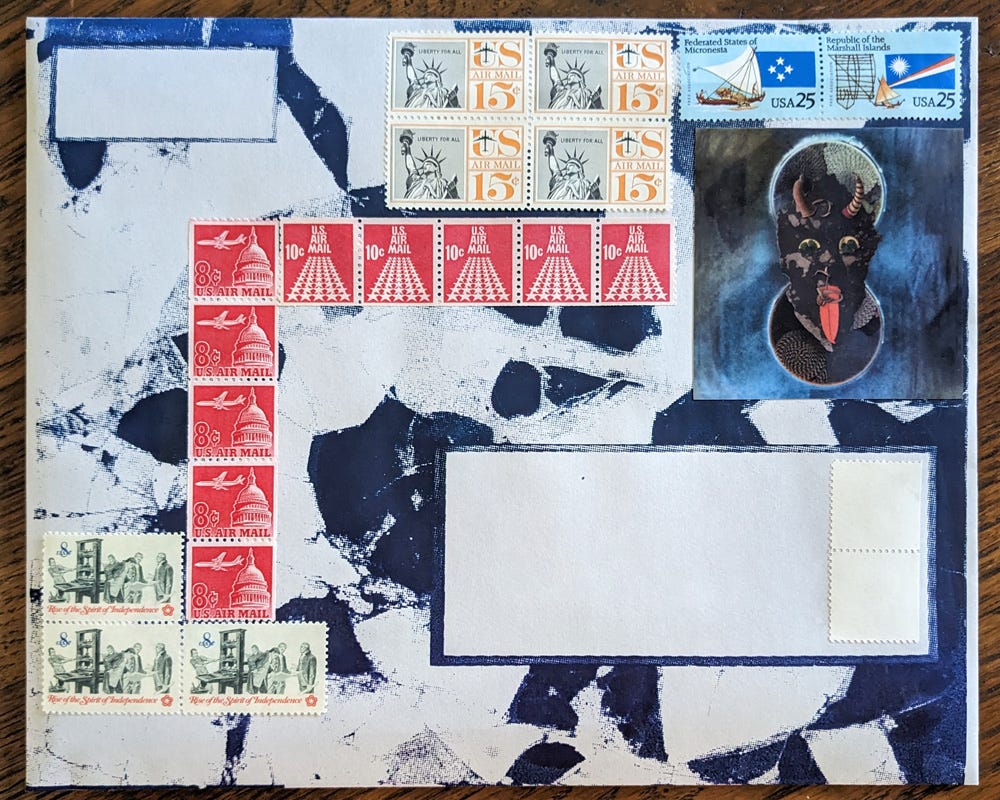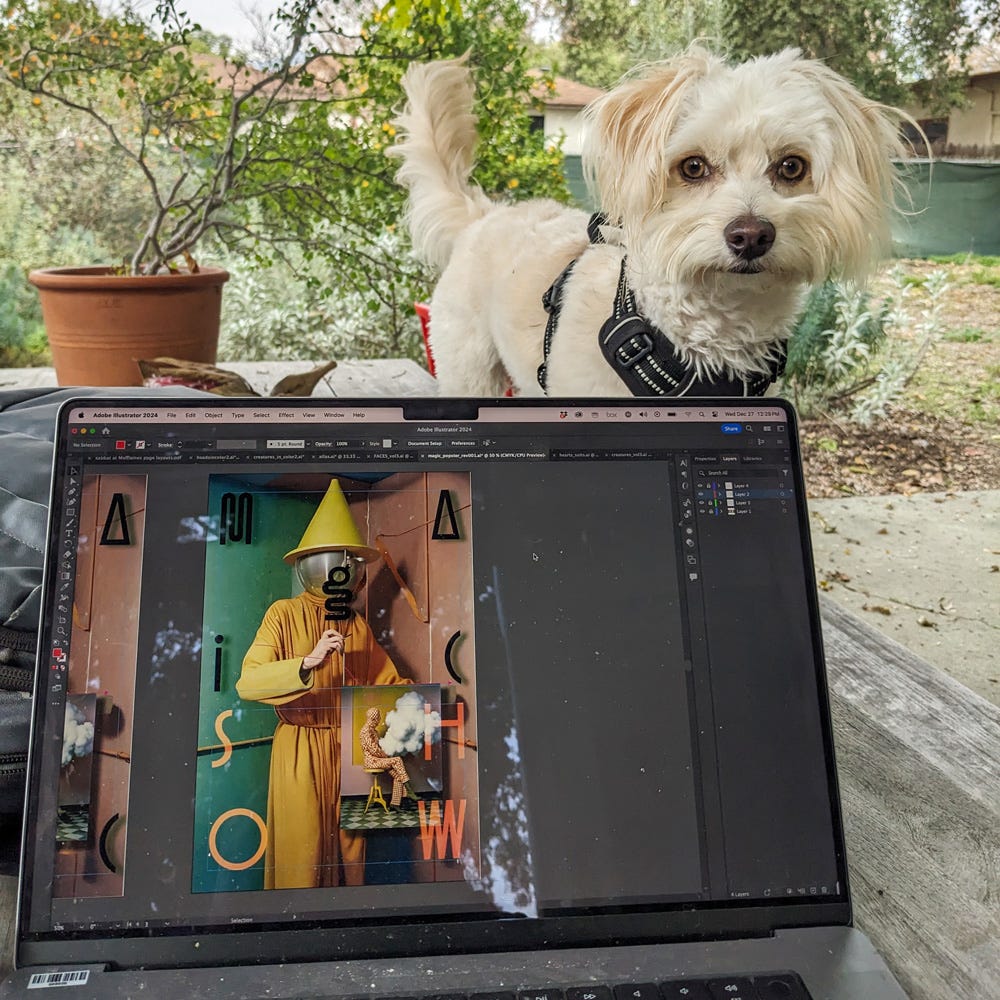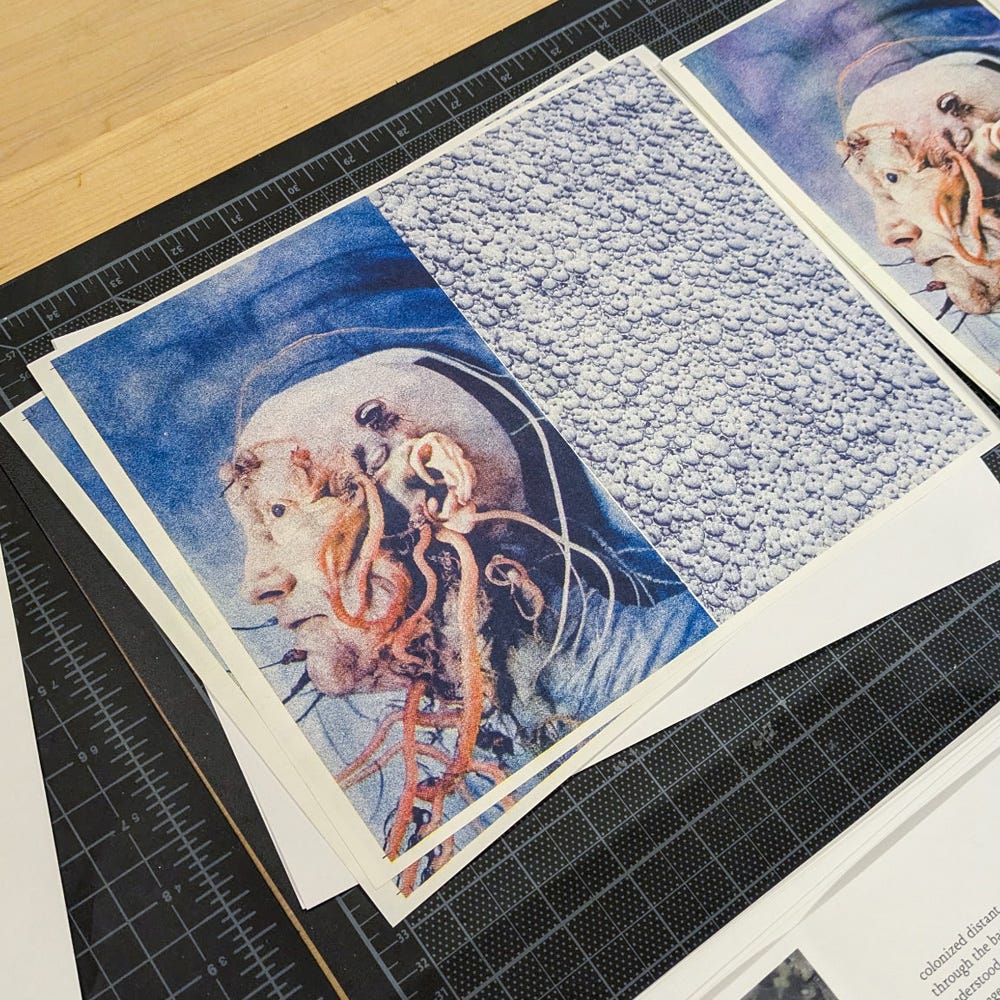Hello! You are reading a special edition of the Current Editions newsletter. Surprise! We’re highlighting the work of our collaborator and friend, Los Angeles-based artist Mark Allen. Winter’s almost over—time to change our clocks and OUR EXPECTATIONS OF AMERICAN GOVERNANCE!!
Our relationship with Mark dates back to the early 2000s when he founded Machine Project. For nearly a decade, Paul designed and screen printed posters for a variety of Machine events, many of which you can view on his website.
We’ve continued to be fans of Mark’s sprawling artistic pursuits over the years. Join us as we dive into time-bending black holes, the magic of the USPS (!!), and how the unconscious mind shapes artistic creation.
–Paul and Jessalyn
Press News
Before we get into the heart of this special edition, we need to report on some recent activities.
In December, we experienced our SECOND(?!) tsunami warning at a book fair during SFMOMA’s Small Press Book Bazaar. We also returned to the East Bay Alternative Book & Zine Fest, which took place in Berkeley this year—shout out to the volunteers who make this event an enduring institution!
2025 kicked off with back-to-back weekends at San Francisco’s Fort Mason: Colpa Press’ BOG at the FOG Fair in late January, and Rare Books SF earlier this month. Thank you to everyone we met—we love to explore ideas with you!!
We also joined Bluesky. Come yell at us.
Back to Mark. When he first showed us his Non-Cartesian Notepad, we were amazed. We knew we had to co-publish it with Quel Désastre Party Bear, Mark’s press. So we did.
It’s perfect for capturing revolutionary ideas, sketching impossible architecture, and plotting trajectories through wormholes and between black holes. Note: we are not responsible for any resultant revolutions (though we wholeheartedly welcome them).
Purchase Non-Cartesian Notepad here
Friends in Focus—Mark Allen Edition!!
We had the pleasure of speaking with Mark in early February. He shared how patterns, collaboration, and the unexpected shapes his work. Below is our conversation.
Patterns appear so often in your work—what keeps you coming back to them?
I love complexity, things overlapping and influencing each other, order appearing out of non-order and chaos emerging out of order. I believe pattern is one of humanity's core aesthetic pleasures. Proto humans were making patterns on things for thousands and thousands of years before we came along.
The Non-Cartesian notepad obviously stems from this belief!
I often sketch on graph paper, and I started to think about what could happen if the organizational structure of the grid got transformed or disrupted in some way. Also, I adore those grid diagrams that show how gravity bends and how black holes affect time.
Your recent work incorporates literary and poetic text. Has language always influenced your work?
Well I am a very avid reader, and do most of my reading on my phone. This allows me to easily save sentences or phrases that struck me in some way. At the end of every other year or so I collect and edit them into an abecedarium that gets mailed out. The last one was a small publication, this year I’m sending a postcard for every letter, one a week for 26 weeks. Secondly, I like my mailings or publications to have some kind of theme, and I enjoy designing something with an associated text.
When the pandemic started, I stopped designing event posters (no events) and started making things that could be sent by mail. At the same time, my wife (and awesome artist) Emily Joyce started writing—first stories that she read to me during our pre-dinner cocktails, then lyrics for our band Puzzle Blood, and now poems, which often play a role in my publications.
Once you start including text, you have to think about fonts. Any controversial takes?
I love a wacky display font! I also do a lot of hand lettering in my notebooks, I think it comes from being inspired by so many CalArts Graphic Design Posters that forefronted energy and vibes over legibility. For body type I tend to bounce around similar but different typefaces with each project. I’d like to settle down with just a couple body fonts and really get to know them instead of being so capricious.
Your affinity for snails is clear. Recently you designed a poster for the American Malacological Society. It was the poster we didn’t know we needed!
Ha! Yes. Well many years ago when I was the director of Machine Project, we hosted a talk called “The Sex Life of Sea Slugs” by biologist Patrick Krug, and I was delighted with the excessive appearance of sea slugs, as well as their polymorphous sexuality. Many years later Patrick asked me to donate a work of art for the annual meeting of the American Malacological Society, so I made the poster which is a zero percent scientifically accurate decorative fantasia of snail styles.
Also, snails are so easy to draw and make a great canvas, so they became a regular motif of mine for a while. A couple years ago my friend Amy Byrne was generous enough to embroider a snail shirt for me .
Our relationship developed through a mutual love of print. What draws you to print and posters?
Again, from going to Cal Arts and loving the posters, then working with Gail Swanlund who helped organize a big team of graphic design students for the long running series of posters for Machine Project Events. Paul got pulled in when I needed someone to screenprint poster and print editions that Machine was making for museums and various projects. He did a ton of the printing in Oakland and shipped them down to us.
I think my current love of patterns was inspired by seeing the over the top things he was doing in his work, which included an intense screen printed wall pattern of his designs we commissioned for a show in St Louis. As I made the transition to designing and screen printing my own work, Paul taught me so much via novella length text message responses to basic questions I was asking for help with. Incidentally he still does this for me with my Riso questions. Thanks Paul!
I love print and posters for their physicality, the way they are a combination of the intent of the designer, the desires of the medium, and unquantifiable “what just happened?” moment during the process. And of course, I love how easy they are to share and distribute. They possess the magic of the human made object without the exclusivity challenges of many artforms.
Having presented our work together at various art book fairs, we appreciated how your work (in juxtaposition to ours) draws in an audience that appreciates mystery and ambiguity.
Yes, I think that’s just my style, in general art is good at creating complex experiences that are a bit hard to sum up in words, and I try to let the unconscious and intuitive parts of my brain get equal time in my process.
Characters (animal, human, uncategorizable) often appear in your work—where do they come from?
I go to a lot of meetings and (like many people) I’ve realized I pay attention better and enjoy myself more if I’m also drawing at the same time. It’s also nice to spend time between other things by drawing for five minutes here and five minutes there. Who knows where they come from.
How did running Machine Project impact your art practice? You once described yourself as something like the “carnival ringleader” of Machine, which seemed apt.
I think my philosophy of making lots of stuff, all the time, about whatever seems interesting was my core idea with Machine, and it’s my core idea now; it’s just the form has changed. Similarly my desire to connect with people is strong. Then it was through events and exhibitions, now through the mailbox.
Hit us with some USPS talk.
There is very little that we receive via that postal service that isn’t either trying to sell us something, or reminding us we owe money for something we bought—like water or trash pickup. On the other hand, sending someone a publication or card or mysterious print is a gesture of connection and creative expression. It pierces through our usual transactional relationship with the mailbox, creating a moment of surprise and delight that exists purely for its own sake.
I’m not trying to extract anything from the recipient—I’m simply saying “I thought of you” or “I wanted to share this piece of my imagination with you.”
It's a small act of resistance against the commodification of our communication channels, transforming the postal service back into what it perhaps was always meant to be: a bridge between people, not just between accounts and invoices.
Something I love about you as an educator is how you turn your classroom into such an active, “alive” studio space; which includes you as an artist making work there.
I am very lucky to be able to make a living as a teacher. I love being part of a group of folks who are interested in learning through making art. I like helping students discover what they are authentically interested in, sharing the excitement of art and design in the world that I love, and giving people permission to do things that might not seem wholly rational to the larger world. Teaching art is so much less about specific knowledge you need the students to learn, and more about providing conceptual and technical scaffolding for them to build on.
You are also known as someone who goes on to have deep collaborative relationships with students. Collaboration seems to be a core part of your practice.
Generally making things with people is my favorite way to have a relationship with them, since making things is my favorite way to spend my time.
What is coming down the pike?
I have a tetraflexagon I’m designing. I’ve been drawing lots of fantastical flowers and ice cream cones with faces, I made a photopolymer intaglio plate for an accordion publication I plan to print, and I’ve been thinking about Borges’s horror of mirrors.
I am continuing to work on developing non-corny and surprising ways to use AI in aspects of my image making. I just finished a small science fiction publication called The Archimboldo Apartments with writer Jonathan Lethem. To be honest though, for everything I finish there are ten things I start, so I never really know what is next.
For me ideas always appear during the process of making things. Students sometimes think the first thing is to think of a good idea, and then materialize that idea into an artwork. This is not how creativity happens in my experience.
I’ve also been gradually organizing all my publishing under an imprint I’m calling Quel Désatre Party Bear. qdpb will be joining Current Editions at the Printed Matter LA Art Book Fair this May!
Mark is at markallen.com
See You Soon
It pains us to say this, but we’re taking a short break from fairs. We’ll be working on new publications this spring and will reemerge in May!
Los Angeles: Printed Matter’s LA Art Book Fair, May 12–15 at ArtCenter College of Design. We’ll be tabling with Mark—come say hi!!
Mystery City: Cool Book Fair, Spring-ish in another state! You’ll hear all about it in our next newsletter.


